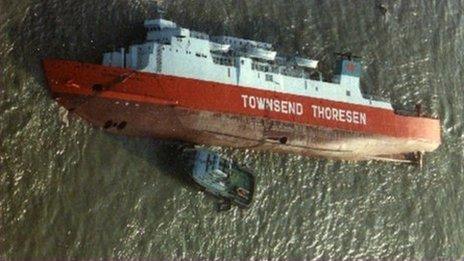Felixstowe: The ferry disaster that killed six men 40 years ago
- Published
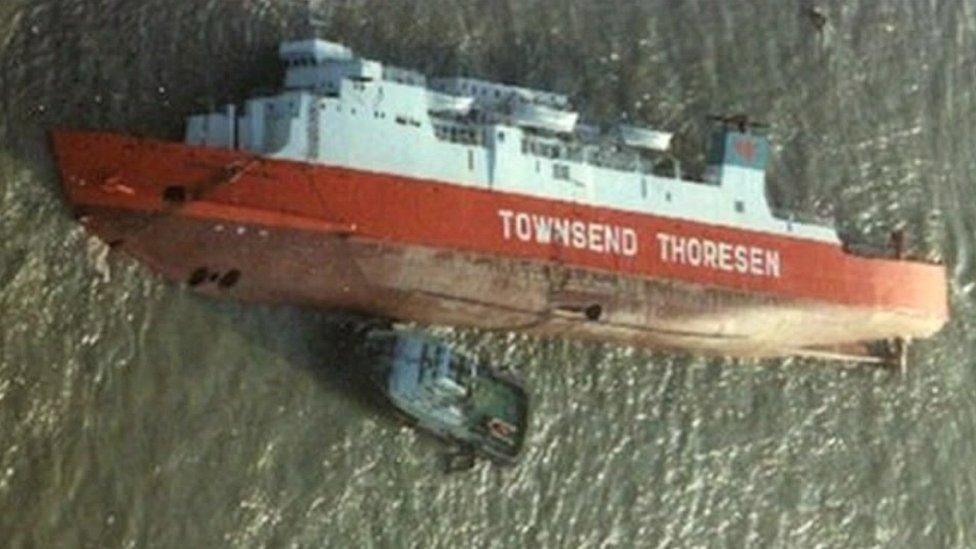
The European Gateway, owned by Townsend Thoresen, was outbound from Felixstowe to Rotterdam when it collided with Speedlink Vanguard
Four decades ago two cargo ferries collided beneath strong moonlight off the Suffolk coast in a tragedy that left six men dead. What happened and how is it remembered by those involved?
Shortly before 23:00 GMT on 19 December 1982, the 3,949-tonne European Gateway and the 5,555-tonne British Rail-owned Speedlink Vanguard collided a little more than two miles offshore.
Within half an hour, the seriously damaged Gateway had turned on its side in the shallow waters and capsized. After an order was made to abandon ship, the crew and lorry drivers ended up in the water.
There were 70 people on board. Two lorry drivers and four crew members died that night.
An inquest found the men died of hypothermia in the icy waters and the 10-strong inquest jury returned open verdicts in the deaths of all six.
Simon Dowers, of Martlesham, near Ipswich, was a 23-year-old able seaman on the European Gateway on the night of the tragedy.
Earlier that day, the Gateway had hosted a carol concert before it set sail from Felixstowe at about 22:30.
Placed on second watch, Mr Dowers went to turn in, expecting to be woken half way across the North Sea to tend to his duties, which included general maintenance and tying up the vessel once they reached Rotterdam.
"It was blowing a Force Seven or Eight [gale] that night, so the ship gets into a movement and it starts pounding into the waves. You get used to it and you come to expect the next one.
"Then there was this peculiar movement and you thought, 'oh, what's that?'."
"I lay there and waited for her to start again but at that point all the lights went out."

Simon Dowers remembers jumping into the cold winter waters with one of the men who died in the accident
A short time later, the emergency lighting came on, followed by a series of blasts from the ship's hooter.
"If you hear three it means you are going astern, if you hear two, it means you are turning to port," he said.
"I was laying there and when she got to six there is not many more than six."
He heard seven short bursts followed by a longer one. It was the call to abandon ship.
"I got up, put some clothes on and grabbed my life jacket."
Seaman are trained to go to their boat station - an assigned meeting space - in such emergencies.
"My boat station was port side - but by the time I'd got to the port side of her, she was already listing badly," he said.
"When I got to my boat station we could not get the lifeboat away because she was listing too far.
"I just let go and slid down to the starboard side. There were a number of people milling around and there was one young lad who seemed quite stressed so we tried to calm him down," he said.
"If a ship sinks perfectly flat then you can get all the lifeboats away. But if she goes over, one way or the other, then the davits (a crane-like device that lowers the lifeboats) have a tendency to trap the lifeboat.
"We couldn't get the lifeboat away."
The men killed that night were:
Graham Welton, 27, a lorry driver from South Humberside
George Heath, 48, a lorry driver from Manchester
Pewel Burzik, 59, a crew member from London
Albert Coburn, 49, a crew member from Larne, County Antrim
Tony Mason, 40, a crew member from Colchester
Joseph Topp, 50, a crew member from South Shields

The collision
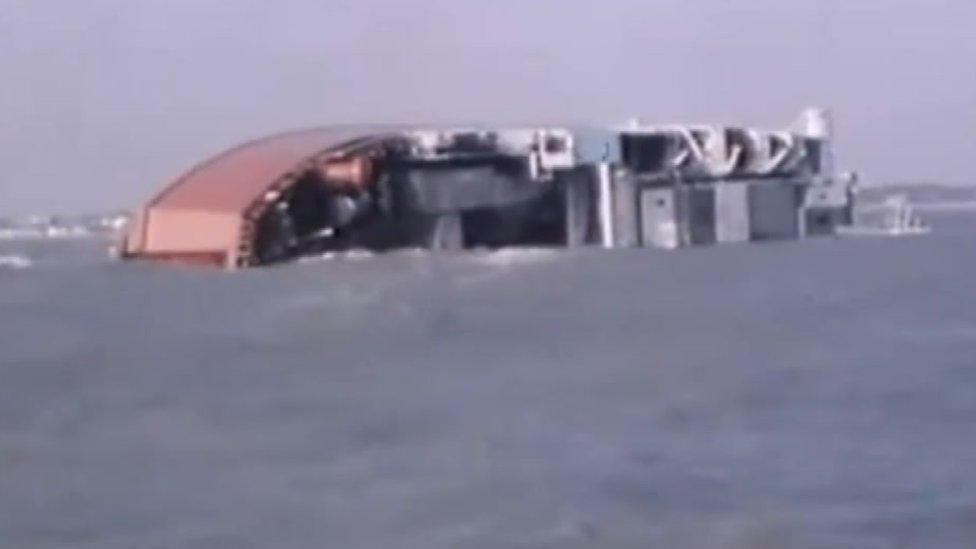
Shortly before 22:50 GMT, the crews of both the European Gateway, heading from Felixstowe to Rotterdam, and the Speedlink Vanguard, which was carrying rail wagons, heading from Rotterdam to Harwich, begin manoeuvres to avoid each other
At 22:51, the two ships collide near Cork Spit Buoy off Felixstowe and the European Gateway is holed
A public inquiry in 1984 was told the Gateway had attempted to pass in front of the Vanguard and three of its watertight doors were open at the time of the collision
Within 10 minutes of the collision, the Gateway capsized as it flooded and its starboard side came to lie on the sea floor
At 22:55, the Trinity House pilot vessel Valour approached the ferry Dana Futura in a call for help before making its way to the scene of the collision
For the next three hours the Dana Futura was positioned about 400m east of European Gateway to take survivors, who were picked up by the smaller rescue vessels
From 00:01 the next day, helicopters from RAF Manston and Coltishall, USAF Woodbridge and Koksijde in Belgium began to arrive and carried out illuminated searches of the area
By 02:30, all but one of the Gateway's complement had been accounted for
Despite further lifeboat launches the following day the missing man was not found and the search was called off at 14:07

Mr Dowers remembers the brightness of the moon that night.
"I can't remember there being any panic," he said. "Everybody seemed to be doing what they should be doing.
"Not long after that the pilot cutter turned up. The guy in the pilot cutter backed in against the lifeboat and then a number of people used her as a stepping stone onto the pilot cutter without even getting wet.
"As the guys got on to the pilot cutter, we heard the cargo shift down below."

Faced with the ferry turning over towards it, the pilot cutter put the engine to full ahead to get out of the way.
"At that point there was myself and two others and we looked at each other wondering what to do. We jumped in.
"One of the guys who jumped in with me perished. Going into the sea in December, it is not good.
"I think as he hit the water, he just drifted away.
"Somebody on the back of the pilot cutter threw me a life buoy. He missed. I shouted a few expletives at him suggesting he try again, which he did.
"I got my arm into the life buoy and the skipper went full ahead and pulled me out of the way. They got me on to the pilot boat."
Mr Dowers continued working on ships until he got a job at Felixstowe docks in 1986.
"I don't dwell on it," he said. "You've got to move on. But I feel sad for the people who passed away.
"The guy who jumped in with me was probably the age I am now. I was 23 at the time so the cold water for me, at 23, wasn't as bad as it was for somebody my age now."
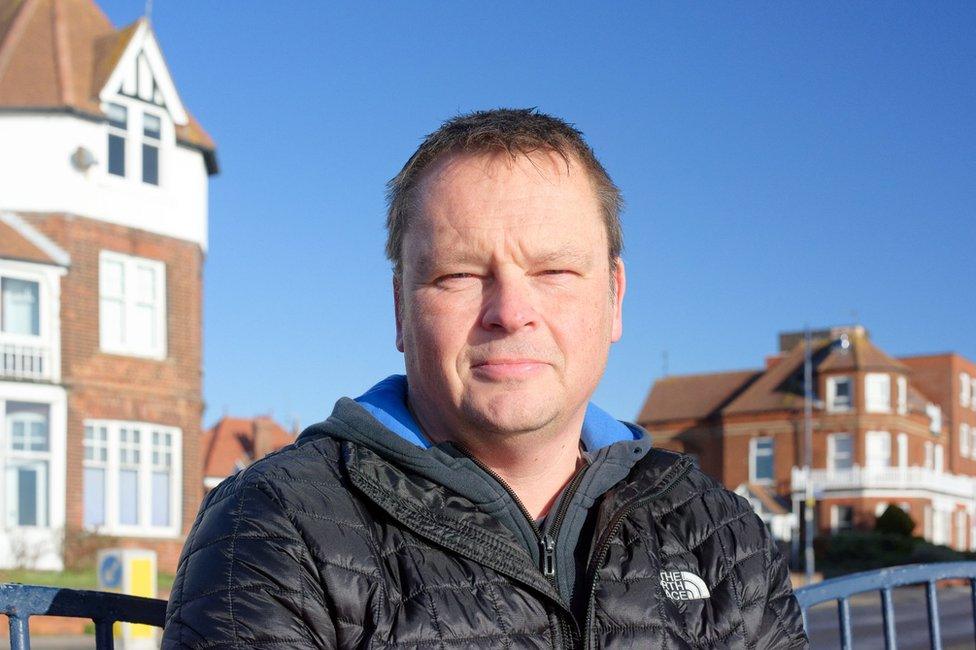
Darren Aitchison has been in contact with a number of families of those who died in the tragedy
Back on land was a 12-year-old Darren Aitchison.
"I was a sea cadet when it capsized and one of our staff worked for Townsend Thoresen so we knew as it was happening," he said.
"The next day we could see it on its side. At that stage, we did not know people had died.
"I remember it looking a lot closer than it was to the shore."

You might also be interested in:

Mr Aitchison, who is now an independent town councillor, is trying to get a new memorial installed that carries the names of those who died that night.
He has been in contact with a number of families of those who died in the tragedy.
The idea of adding the names of those who perished to the memorial has been well-received by families, he said.
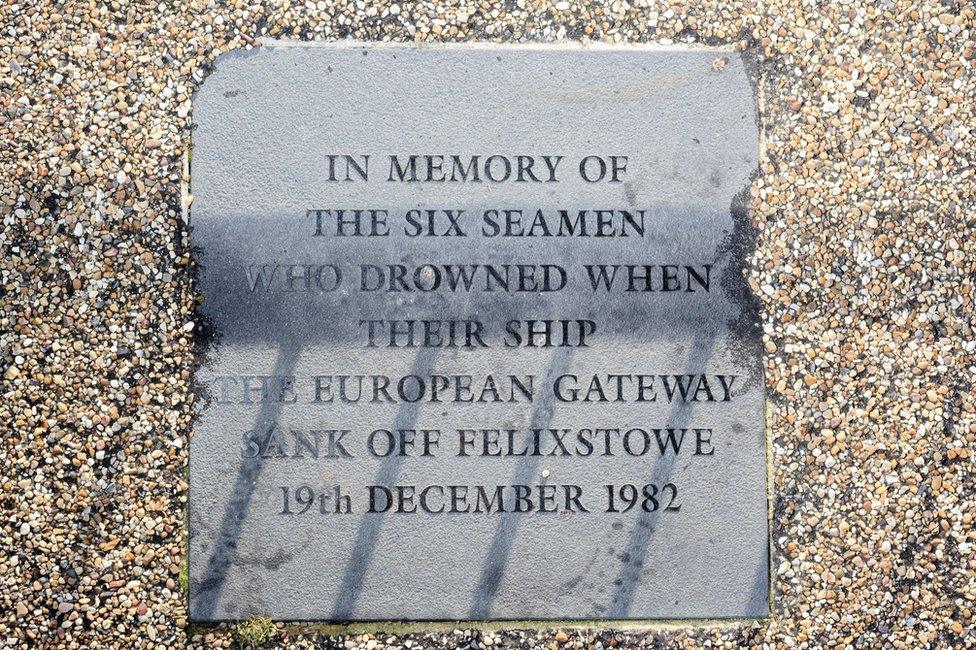
The existing memorial is expected to be replaced with a new one bearing the names of the seamen and lorry drivers who perished in the disaster
"A lot of people have stories about that night," he said. "It continues to have a massive effect on the town because it was a massive disaster that happened within a mile or so of the beach.
"It is something we need to keep remembering.
"Everybody that was here at that time remembers it and thinks about the people who died that night."

Find BBC News: East of England on Facebook, external, Instagram, external and Twitter, external. If you have a story suggestion email eastofenglandnews@bbc.co.uk, external
Related topics
- Published20 December 2013
